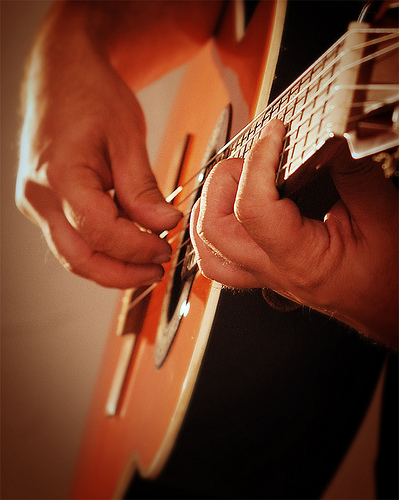Musical Fluency: Building Fingerpicking Technique

When I was finishing up high school and looking toward college auditions, I had miserable fingerpicking technique.
Yet, despite having very little experience in fingerpicking styles, I decided to study classical guitar in college at my teacher’s recommendation. So I had some catching up to do with my right hand!
I had six months to prepare for auditions after buying my first classical guitar, and I did some serious woodshedding. Thanks to this work, I not only passed the audition and got accepted into the classical guitar program, but I also began teaching classical guitar at the same university just three years later.
Here are a few ideas that really helped me whip my fingerpicking technique into shape in a short amount of time.
Pick a Pattern
The more patterns your picking hand tackles, the more versatile your fingerpicking technique will be. So I’d recommend working on a different pattern each time you practice.
To come up with a pattern to work on, just follow these guidelines:
- 01. Create a fingerpicking pattern between 3 and 8 notes long
- 02. Start the pattern with the thumb
- 03. Choose the rest of the fingers at random.
Let’s come up with an example. Step one, how about a five-note long pattern? Step two, we’ll start the pattern off with the thumb. That leaves four notes left in the pattern. Step three, we’ll pick the rest of the fingering at random. You can literally draw the rest of the notes out of a hat. Just write down “thumb,” “index,” “middle” and “ring” on pieces of paper and drop them in a bowl or hat.
After drawing the rest of the pattern at random, here’s what I ended up with:
thumb, index, thumb, ring, middle
So that’s the fingerpicking pattern for the day.
Choose Your Strings
Generally, the thumb of the picking hand plays the lowest three strings, while the index, middle, and ring fingers play the G, B, and E strings respectively.
Feel free to mess around with which string each finger is assigned to, but let’s start simple. For our example, the thumb plays the sixth string, index plays the third, middle plays second, and ring plays first.
The Fretting Hand
So what do you do with your fretting hand while the picking hand is practicing the pattern you’ve come up with?
At first, don’t do anything with the fretting hand. Just work on the fingerpicking pattern with open strings until you start to get the hang of it. As it starts to sink into your muscle memory, then try adding the other hand.
There are a couple different practices I recommend to students while working with fingerpicking patterns. Let’s look at each one…
Open Chords
One really simple exercise while working on a fingerpicking pattern is to just play open chord changes. Play the pattern a set number of times on an open position chord before switching to another.
For example, try the pattern four times on a G major chord, then four times on an E minor chord.

If you get tired of hearing these chords, throw in new ones. Try four times on C, then four times on A minor, with the thumb of the picking hand on the fifth string. I actually like to make up the chord progression as I go. While I’m repeating the fingerpicking pattern on the first chord, I try to decide on the next chord.
New Chords
Whenever I’m practicing technique, I like to work on more than one thing at a time. Doing this can make your practice time really efficient.
So why not work on something new in your fretting hand while your picking hand is getting a workout with a fingerpicking pattern?
Let’s say you just ran across a new chord shape that you want to get under your fingers. Fret this new chord shape at the first fret, and then play through your fingerpicking pattern four times. Then move the chord shape up the the second fret and repeat the pattern four more times. Continue with this exercise one fret at a time all the way up to the 12th fret, and maybe even back down the guitar for some extra practice.
Here’s an example using a Maj9 chord shape. The picking pattern has been adjusted to match with the strings used in the chord shape.

This exercise works out your picking hand with a new pattern, and at the same time locks a new chord shape into your fretting hand.
Spend some time on these exercises with a new pattern every day, and you’ll see vast improvement in your comfort with fingerpicking!
Image courtesy of James Jordan
Ben Rainey works as a guitar teacher and freelance guitarist in the Pittsburgh area. He's also in charge of music content at Tunessence.com.
Get The Pick Newsletter
All the latest guitar news, interviews, lessons, reviews, deals and more, direct to your inbox!









![Joe Bonamassa [left] wears a deep blue suit and polka-dotted shirt and plays his green refin Strat; the late Irish blues legend Rory Gallagher [right] screams and inflicts some punishment on his heavily worn number one Stratocaster.](https://cdn.mos.cms.futurecdn.net/cw28h7UBcTVfTLs7p7eiLe.jpg)
